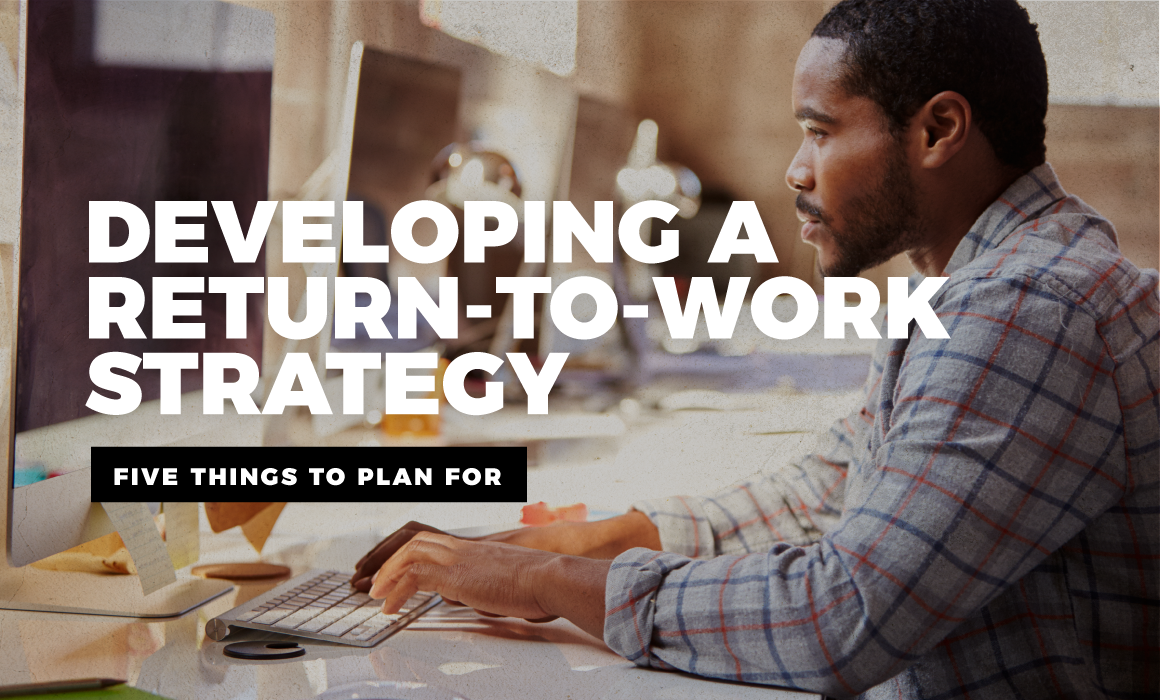Five Things to Plan for as Your Workforce Returns Post-COVID-19
As recent as a few weeks ago, we were still talking about going “back to normal.” But as we’ve learned and observed alongside our clients and our own staff, it’s obvious that work life and culture as we know it have been forever changed. We will “go back,” just not to normal.
When employees who have been working remotely or have been furloughed go back to their workplaces, things will be different. This is an opportunity for leaders to “reboard” employees, and even strengthen or reinforce culture and values through clear communications and human centeredness.
Together with Rebecca Ellis, managing director of the Performance Lab, we are sharing five areas employers should address in their return-to-work strategy:
1. Leadership visibility
During the uncertainty of the COVID-19 pandemic, many leaders became chief empathy officers. They focused on their people, and they ensured employees felt heard and cared for. Don’t lose the momentum you may have built during this time by assuming your people know you still care. Stay visible and keep up frequent, empathetic communication.
2. New world, new messaging
Especially in the first weeks back, you’ll have to address topics you may have never addressed before or need to address in new ways. Employees will want to know what safety procedures you’ve put in place. They’ll want to know how they should handle customer interactions. Will they be expected to follow the same processes, or have things changed? And what is our priority now? Are there opportunities for employees to help shape the way you operate in a post-pandemic world? You’ll want to address all these questions in a well-thought-out way. Even if you don’t have all the answers (spoiler alert: no one does), let your employees know that you understand their concerns and their need for direction.
3. Internal communication tools/channels
Are the days of in-person all-staff meetings over, or dramatically changed? In the midst of the pandemic, did you start using a tool or a channel you hadn’t used before? How did your technology help or hinder you? Consider the lessons learned and use this opportunity to shore up your communications channels to take advantage of any new habits your organization built during the remote working time. If communication was a challenge, survey your employees to gather their ideas on how you could overcome challenges in the future with new technology or processes for staff communication.
4. The evolving role of the frontline and mid-manager
Did your frontline managers step up to the challenges your business faced during the COVID-19 crisis? Are they well-equipped and willing to embrace their critical role as chief communicator to their teams? We often promote people into management positions because they were good at a technical skill. But management skills are much broader than technical skills and really boil down to the ability to make good decisions and to bring teams together. If they struggled with these two actions, what can you do to help them grow into better managers?
5. New norms
Chances are, there are some healthy new organization and individual behaviors that were developed during shelter in place. Perhaps work life is actually in “balance” for many for the first time in their careers. Perhaps you’ve innovated and implemented new solutions at a pace never before seen. You want to keep these things, right? What are you planning to help the positive change stick?
This list provides a few important things to consider as you plan for your employees to return to the workplace. Ultimately, effective reboarding will require taking the best shelter-in-place learnings and carrying them forward. It will also require that you clearly define expectations for the next iteration of the work environment so your team knows what to expect. And, if you haven’t invested time and energy into building empathetic, people-focused leaders, there’s no time like the present.
Contact Katherine Coble if you need additional support or training when it comes to developing your communications strategy and plan for employee reentry post COVID-19.


